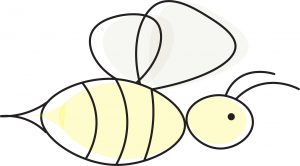 Common stinging insects include bees, hornets, yellow-jackets and wasps. When they sting, they inject a venom, which has toxic effects; this means that it is irritating and provokes swelling, redness, itch or pain. All these reaction are normal. But if you are allergic to this venom, then you may suffer a more serious and generalized reaction.
Common stinging insects include bees, hornets, yellow-jackets and wasps. When they sting, they inject a venom, which has toxic effects; this means that it is irritating and provokes swelling, redness, itch or pain. All these reaction are normal. But if you are allergic to this venom, then you may suffer a more serious and generalized reaction.
Wasp is the common name applied to most species of Hymenoptera insects, except bees and ants. Wasps have a slender body with a narrow waist, slender, cylindrical legs, and appear smoothed-skinned and shiny. Yellowjackets, baldfaced hornets, and paper wasps are the most common types of wasps encountered by people.
Bees are robust-bodied and very hairy compared with wasps. Their hind legs are flattened for collecting and transporting pollen. The honey bee is about 12 mm (1/2 inch) long and usually yellow, with 3 or 5 dark brown abdominal bands. They carry two pairs of wings and lack the constricted abdomen (wasp waist) of the wasp and hornet.
Honey bees can sting, but are much less aggressive than wasps and hornets. Only honey bees leave the stinger and poison gland; yellow jackets, wasps, and hornets do not. Honey bees have barbs on their stinger which remain hooked in the skin. The stinger, which is connected to the digestive system of the bee, is torn out of the abdomen as the bee attempts to fly away. As a result, the bee soon dies. If you are stung by a honey bee, scratch out the stinger (with its attached venom gland) with your fingernail as soon as possible. Do not try to pull out the stinger between two fingers. Doing so only forces more venom into your skin.
In certain geographic areas such as South America, red fire ant bite is known to induce allergic reactions. Ocasionally, other insects have been described to cause allergy. This is true for horse flies, ticks, bed bugs or even mosquitoes, although it is very rare.
Local, non-allergic reactions may last up to a week. The sting site should be washed with soap and water. Local reactions can be treated with ice, vinegar, honey or commercial topical ointment (calamine, cortisone) to relieve the itching. Generalized allergic reactions consist of a combination of the following symptoms: hives (urticaria), swelling (angioedema), generalized itching rash, hoarseness, breathlessness, nausea, vomiting, diarrhea, fainting, etc. This is an anaphylactic reaction which requires a thorough allergic evaluation and specific treatment.
